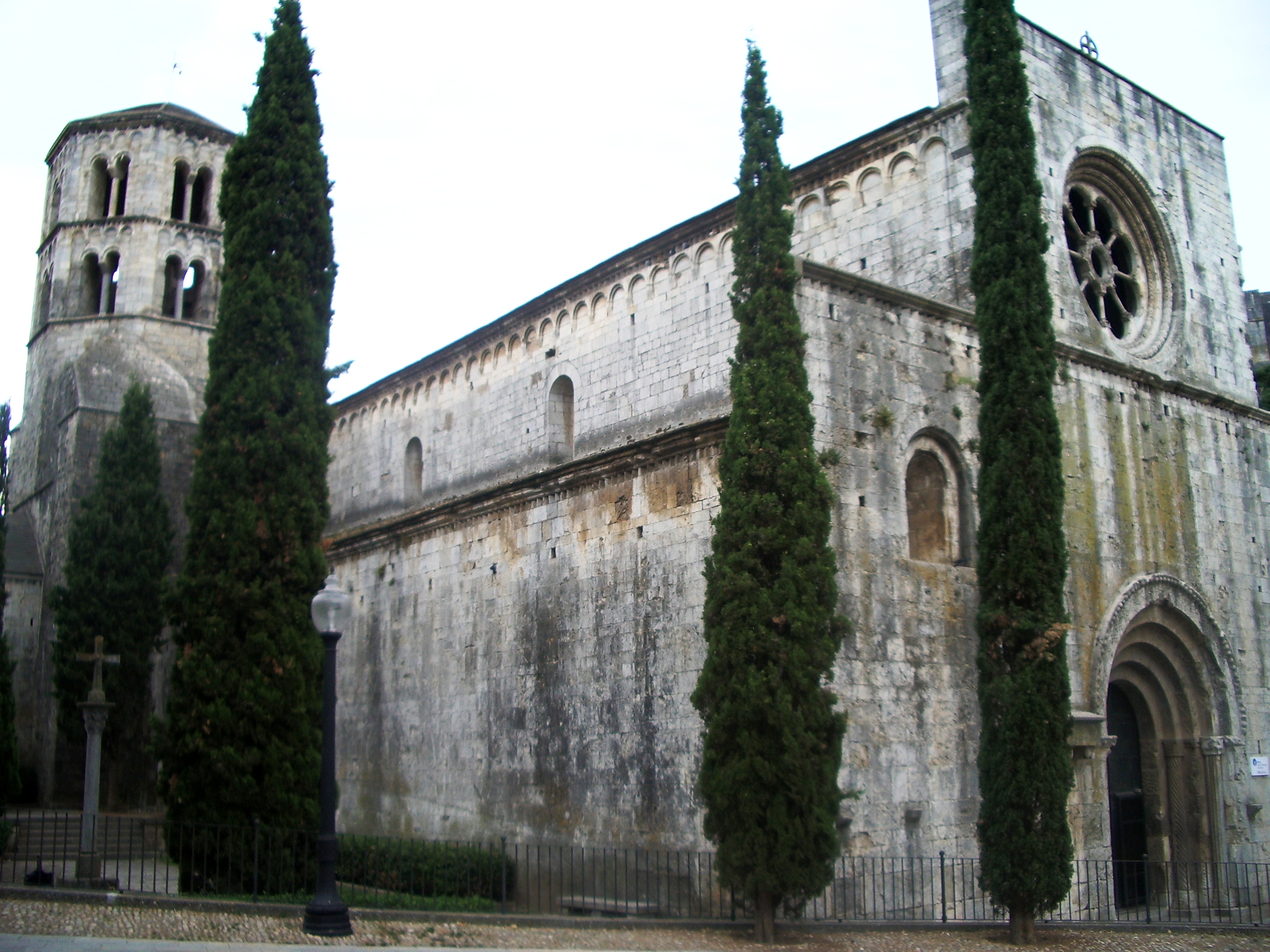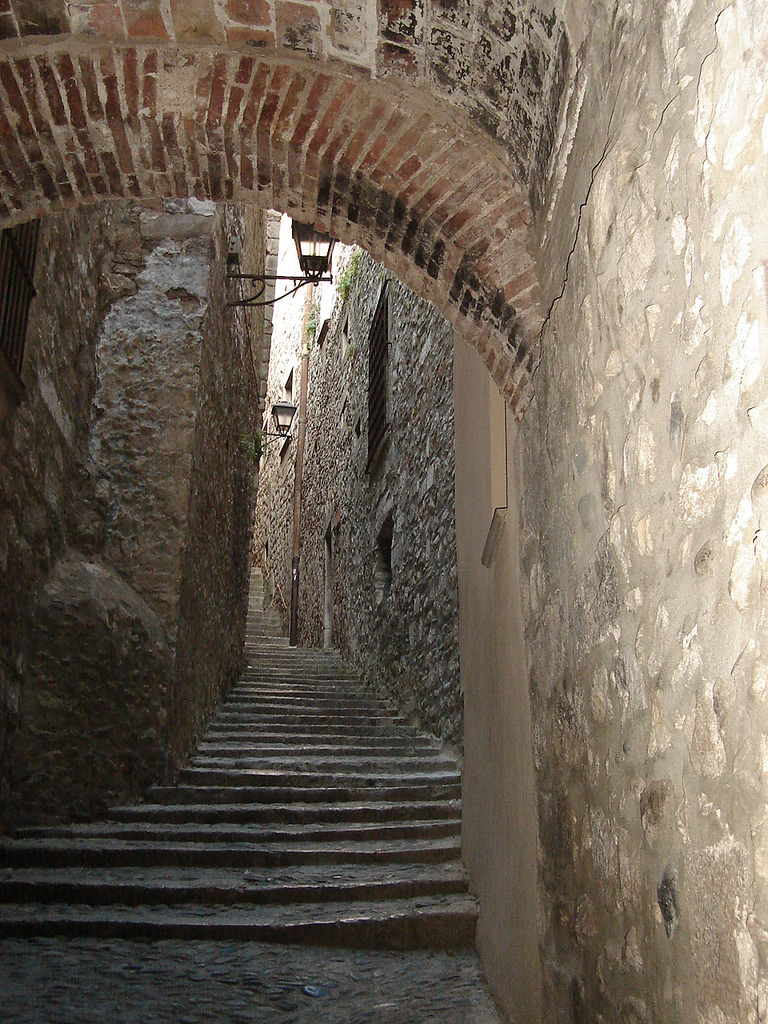|
Arnau Gatell
Arnau Cadell (also spelt Gatell or Catell) was a 12th–13th-century Catalan sculptor. He is best known for creating the cloister of the monastery of Sant Cugat. Biography Cadell was a Catalan architect, sculptor and master builder. He was in charge of a workshop of travelling artisans specialized in ornamentation depicting biblical themes. It is believed that Cadell went to Sant Cugat with his workshop to work on the monastery there. In addition to the capitals and cloisters he designed at the monastery of Sant Cugat, which was begun in 1190, he is also attributed with similar work in the Cathedral of Girona. He has also been linked to the design of the portals of the church of St. Peter in Santpedor and at the Santa Maria de Manresa basilica. The designs created by Cadell on the capitals represent vegetation, Corinthian figures, scenes from the lives of monks and historic themes from the Bible. The Sant Cugat cloister for which he is most widely recognized, contains 144 Cor ... [...More Info...] [...Related Items...] OR: [Wikipedia] [Google] [Baidu] |
Sant Pere De Galligants
Sant Pere de Galligants is Benedictine abbey in Girona, Catalonia. Since 1857, it is home to the Archaeology Museum of Catalonia venue in the city. The name translates to English as "Saint Peter of Galligants", where Galligants refers to the River Galligants that runs past the abby. History The monastery was built from 992, outside the walls of Girona, when Ramon Borrell, count of Barcelona gave to the monks rights over the quarter of Sant Pere. The monks held the ruler of the quarter until 1339, when King Peter IV of Aragon restored it to Aragon. In 1117 Ramon Berenguer III of Barcelona united the monastery to the Abbey of Sainte-Marie de Lagrasse, in what is now France, though Sant Pere kept an abbot of his own and a large degree of autonomy. Sant Pere was never a big community, and the church was not the local parish, and only baptisms were held in the monastery. In 1362, when the monastery was enclosed within the city's walls, it was redesigned to a more defensive shape. ... [...More Info...] [...Related Items...] OR: [Wikipedia] [Google] [Baidu] |
Medieval Catalan Artists
In the history of Europe, the Middle Ages or medieval period lasted approximately from the late 5th to the late 15th centuries, similar to the Post-classical, post-classical period of World history (field), global history. It began with the fall of the Western Roman Empire and transitioned into the Renaissance and the Age of Discovery. The Middle Ages is the middle period of the three traditional divisions of Western history: classical antiquity, the medieval period, and the modern history, modern period. The medieval period is itself subdivided into the Early Middle Ages, Early, High Middle Ages, High, and Late Middle Ages. Population decline, counterurbanisation, the collapse of centralized authority, invasions, and mass migrations of tribes, which had begun in late antiquity, continued into the Early Middle Ages. The large-scale movements of the Migration Period, including various Germanic peoples, formed new kingdoms in what remained of the Western Roman Empire. In the ... [...More Info...] [...Related Items...] OR: [Wikipedia] [Google] [Baidu] |
Romanesque Artists
Romanesque may refer to: In art and architecture * First Romanesque, or Lombard Romanesque architectural style *Pre-Romanesque art and architecture, a term used for the early phase of the style *Romanesque architecture, architecture of Europe which emerged in the late 10th century and lasted to the 13th century ** Romanesque secular and domestic architecture **Brick Romanesque, North Germany and Baltic **Norman architecture, the traditional term for the style in English ** Spanish Romanesque ** Romanesque architecture in France * Romanesque art, the art of Western Europe from approximately AD 1000 to the 13th century or later * Romanesque Revival architecture, an architectural style which started in the mid-19th century, inspired by the original Romanesque architecture ** Richardsonian Romanesque, a style of Romanesque Revival architecture named for an American architect Other uses * ''Romanesque'' (EP), EP by Japanese rock band Buck-Tick * "Romanesque" (song), a 2007 sing ... [...More Info...] [...Related Items...] OR: [Wikipedia] [Google] [Baidu] |
Sculptors From Catalonia
Sculpture is the branch of the visual arts that operates in three dimensions. Sculpture is the three-dimensional art work which is physically presented in the dimensions of height, width and depth. It is one of the plastic arts. Durable sculptural processes originally used carving (the removal of material) and modelling (the addition of material, as clay), in stone, metal, ceramics, wood and other materials but, since Modernism, there has been an almost complete freedom of materials and process. A wide variety of materials may be worked by removal such as carving, assembled by welding or modelling, or moulded or cast. Sculpture in stone survives far better than works of art in perishable materials, and often represents the majority of the surviving works (other than pottery) from ancient cultures, though conversely traditions of sculpture in wood may have vanished almost entirely. However, most ancient sculpture was brightly painted, and this has been lost. [...More Info...] [...Related Items...] OR: [Wikipedia] [Google] [Baidu] |
13th-century Deaths
The 13th century was the century which lasted from January 1, 1201 ( MCCI) through December 31, 1300 ( MCCC) in accordance with the Julian calendar. The Mongol Empire was founded by Genghis Khan, which stretched from Eastern Asia to Eastern Europe. The conquests of Hulagu Khan and other Mongol invasions changed the course of the Muslim world, most notably the Siege of Baghdad (1258), the destruction of the House of Wisdom and the weakening of the Mamluks and Rums which, according to historians, caused the decline of the Islamic Golden Age. Other Muslim powers such as the Mali Empire and Delhi Sultanate conquered large parts of West Africa and the Indian subcontinent, while Buddhism witnessed a decline through the conquest led by Bakhtiyar Khilji. The Southern Song dynasty would begin the century as a prosperous kingdom but would eventually be invaded and annexed into the Yuan dynasty of the Mongols. The Kamakura Shogunate of Japan would be invaded by the Mongols. Goryeo resi ... [...More Info...] [...Related Items...] OR: [Wikipedia] [Google] [Baidu] |
12th-century Births
1 (one, unit, unity) is a number representing a single or the only entity. 1 is also a numerical digit and represents a single unit of counting or measurement. For example, a line segment of ''unit length'' is a line segment of length 1. In conventions of sign where zero is considered neither positive nor negative, 1 is the first and smallest positive integer. It is also sometimes considered the first of the infinite sequence of natural numbers, followed by 2, although by other definitions 1 is the second natural number, following 0. The fundamental mathematical property of 1 is to be a multiplicative identity, meaning that any number multiplied by 1 equals the same number. Most if not all properties of 1 can be deduced from this. In advanced mathematics, a multiplicative identity is often denoted 1, even if it is not a number. 1 is by convention not considered a prime number; this was not universally accepted until the mid-20th century. Additionally, 1 is the ... [...More Info...] [...Related Items...] OR: [Wikipedia] [Google] [Baidu] |
Girona
Girona (officially and in Catalan language, Catalan , Spanish: ''Gerona'' ) is a city in northern Catalonia, Spain, at the confluence of the Ter River, Ter, Onyar, Galligants, and Güell rivers. The city had an official population of 103,369 in 2020. Girona is the capital of the province of Girona, province of the same name and also capital of the ''Comarques of Catalonia, comarca'' of the Gironès and the vegueria of Girona. Since much of the old quarter of this ancient city has been preserved, Girona is a popular destination for tourists, and film productions have used it as a filming location (e.g. ''Game of Thrones''). The city is located northeast of Barcelona. History The first historical inhabitants in the region were Iberians; Girona is the ancient Gerunda, a city of the Ausetani. Later, the Ancient Rome, Romans built a citadel there, which was given the name of ''Gerunda''. The Visigoths ruled in Girona until it was conquered by the Moors in 715. Charlemagne reconquere ... [...More Info...] [...Related Items...] OR: [Wikipedia] [Google] [Baidu] |
Musée Des Augustins
The Musée des Augustins de Toulouse is a fine arts museum in Toulouse, France which conserves a collection of sculpture and paintings from the Middle Ages to the early 20th century. The paintings are from throughout France, the sculptures representing Occitan culture of the region with a particularly rich assemblage of Romanesque sculpture. History The building in which the museum is sited was built in 1309 in the Gothic style and prior to the French Revolution housed Toulouse's Augustinian convent. The convent was secularized in 1793 and first opened to the public as a museum on 27 August 1795 by decree of the French Convention, very shortly after the opening of the Louvre, making it one of the oldest museums in France after the Louvre and the Musée des Beaux Arts in Besançon. It at first housed the Muséum Provisoire du Midi de la République and the école des Beaux-Arts. The Musée des Augustins de Toulouse was one of fifteen museums founded in provincial centres, by a ... [...More Info...] [...Related Items...] OR: [Wikipedia] [Google] [Baidu] |
Catalonia
Catalonia (; ca, Catalunya ; Aranese Occitan: ''Catalonha'' ; es, Cataluña ) is an autonomous community of Spain, designated as a ''nationality'' by its Statute of Autonomy. Most of the territory (except the Val d'Aran) lies on the northeast of the Iberian Peninsula, to the south of the Pyrenees mountain range. Catalonia is administratively divided into four provinces: Barcelona, Girona, Lleida, and Tarragona. The capital and largest city, Barcelona is the second-most populated municipality in Spain and the fifth-most populous urban area in the European Union.Demographia: World Urban Areas – Demographia, April 2018 Current day Catalonia comprises most of the medieval and early modern Principality o ... [...More Info...] [...Related Items...] OR: [Wikipedia] [Google] [Baidu] |
Corinthian Capital
The Corinthian order (Greek: Κορινθιακός ρυθμός, Latin: ''Ordo Corinthius'') is the last developed of the three principal classical orders of Ancient Greek architecture and Roman architecture. The other two are the Doric order which was the earliest, followed by the Ionic order. In Ancient Greek architecture, the Corinthian order follows the Ionic in almost all respects other than the capitals of the columns. When classical architecture was revived during the Renaissance, two more orders were added to the canon: the Tuscan order and the Composite order. The Corinthian, with its offshoot the Composite, is the most ornate of the orders. This architectural style is characterized by slender fluted columns and elaborate capitals decorated with acanthus leaves and scrolls. There are many variations. The name ''Corinthian'' is derived from the ancient Greek city of Corinth, although the style had its own model in Roman practice, following precedents set by the Templ ... [...More Info...] [...Related Items...] OR: [Wikipedia] [Google] [Baidu] |









.jpg)